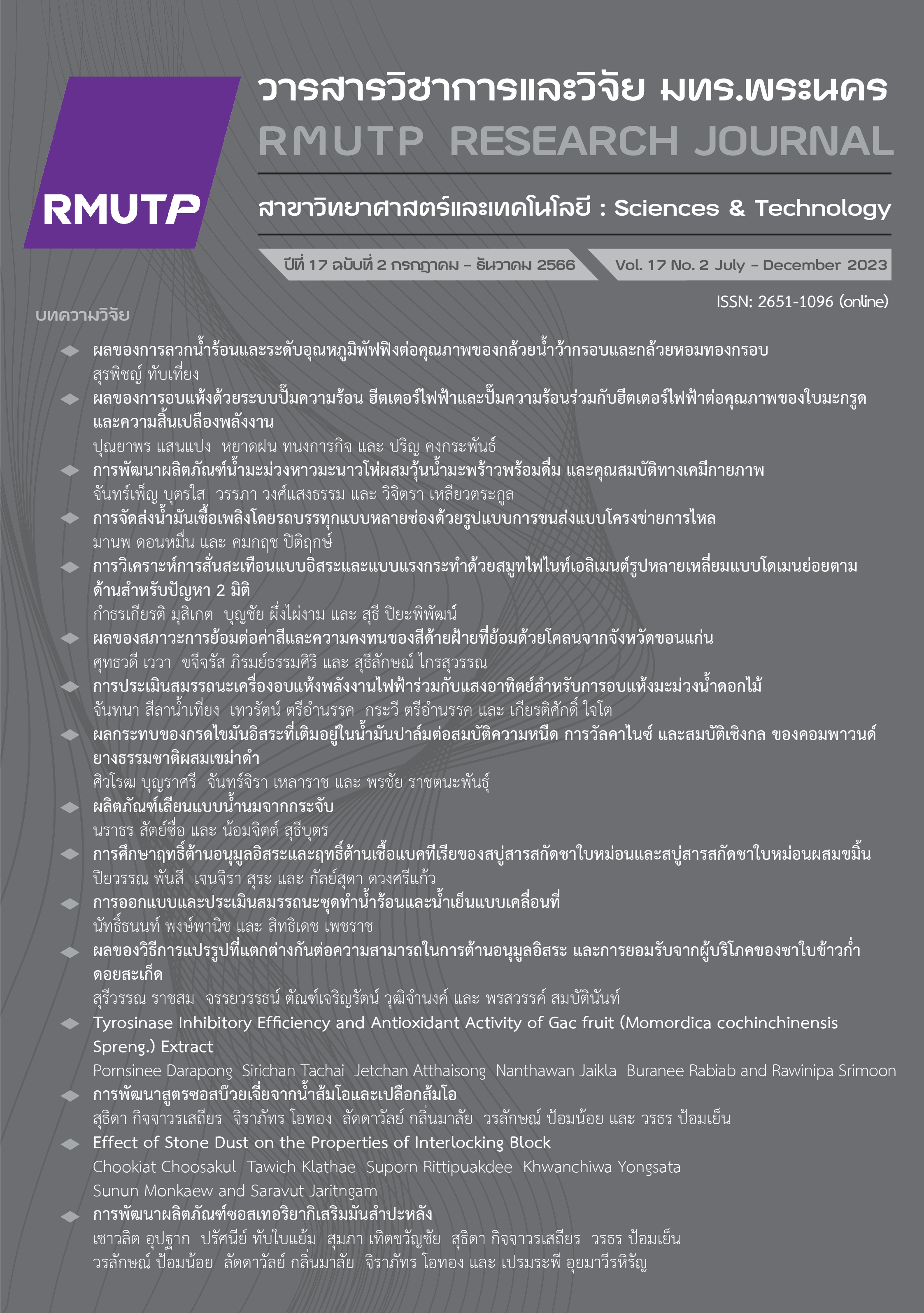การศึกษาฤทธิ์ต้านอนุมูลอิสระและฤทธิ์ต้านเชื้อแบคทีเรียของสบู่ สารสกัดชาใบหม่อนและสบู่สารสกัดชาใบหม่อนผสมขมิ้น
Main Article Content
บทคัดย่อ
งานวิจัยนี้มีจุดประสงค์เพื่อพัฒนาผลิตภัณฑ์สบู่กลีเซอรีนที่มีส่วนผสมของสมุนไพรในท้องถิ่นจังหวัดลพบุรี ได้แก่ สบู่สารสกัดชาใบหม่อน และสบู่สารสกัดชาใบหม่อนผสมขมิ้น แล้วศึกษาคุณสมบัติทางกายภาพและทางเคมีของสบู่ รวมถึงศึกษาฤทธิ์ต้านอนุมูลอิสระของสบู่ด้วยวิธีดีพีพีเอชและฤทธิ์ต้านเชื้อแบคทีเรีย ในการทดลองศึกษาเปรียบเทียบสบู่ 6 สูตร โดยแต่ละสูตรมีส่วนประกอบของเบสสบู่กลีเซอรีน 25 กรัม ได้แก่ สบู่ที่มีการเติมสารสกัดชาใบหม่อนที่ได้จากการสกัดชา 10 กรัม ต่อน้ำ 100 มิลลิลิตร ในปริมาณที่ต่างกันจำนวน 3 สูตร สบู่เติมผงขมิ้น สบู่เติมสารสกัดชาใบหม่อนและผงขมิ้น และสบู่ที่ไม่มีการเติมสมุนไพร (ชุดควบคุม) จากผลการทดลองพบว่าสบู่ไม่มีสิ่งแปลกปลอม ค่าสีของสบู่ที่มีส่วนผสมของสารสกัดชาใบหม่อนมีค่า L* a* และ b* เท่ากับ 14.07 ± 1.44 ถึง 19.47 ± 0.14, -0.05 ± 0.14 ถึง 0.80 ± 0.12 และ 2.13 ± 0.08 ถึง 3.25 ± 0.40 ตามลำดับ ในขณะที่สบู่ที่เติมผงขมิ้นมีค่า L* a* และ b* เท่ากับ 20.06 ± 1.01, 4.98 ± 0.29 และ 6.52 ± 0.26 ตามลำดับ สบู่มีค่า pH 9.36 - 9.83 ปริมาตรฟอง 66.33 - 76.67 มิลลิลิตร ความคงทนของฟอง 62.33 - 70.67 มิลลิลิตร ค่าร้อยละการสึกกร่อน 23.09 ± 2.15 ถึง 25.08 ± 1.23 ฤทธิ์ต้านอนุมูลอิสระของสบู่มีค่าร้อยละการยับยั้ง 18.38 ± 0.93 ถึง 53.36 ± 0.39 และเทียบกับสารมาตรฐานกรดแอสคอร์บิก คือ 1.25 ± 0.01 ถึง 3.45 ± 0.11 AAE/สบู่ 1 กรัม โดยสบู่ที่มีส่วนผสมของสมุนไพรมีฤทธิ์ต้านอนุมูลอิสระมากกว่าสบู่ที่ไม่เติมสมุนไพร และสบู่สามารถต้านเชื้อแบคทีเรียแกรมบวก Bacillus cereus และ Staphylococcus aureus
Article Details

This work is licensed under a Creative Commons Attribution-NonCommercial-NoDerivatives 4.0 International License.
ลิขสิทธ์ ของมหาวิทยาลัยเทคโนโลยีราชมงคลพระนครReferences
M. R. Chirani, E. Kowsari, T. Teymourian and S. Ramakrishna, “Environmental impact of increased soap consumption during COVID-19 pandemic: Biodegradable soap production and sustainable packaging”, Science of the Total Environment, vol. 796, no. 149013, pp. 1-11, 2021.
J. Siriboriruk and S. Prueksaritanond, “COVID-19,” BJM, vol. 7, no. 1, pp. 89–95, Jan. – Jun. 2020.
N. Chaitiang, “Preventive measures for newly emerging COVID 19 infection,” Public Health Policy & Law Journal, vol.7, no. 3, pp. 541-553, Sep. - Dec. 2021.
N. Chamchoi, A. Bulsathaporn and C. Bunyagidj, “COVID-19: Prevention under Environmental Health Perspective” Journal of Health Science, vol. 30, pp. 376–388, Jul. – Aug. 2021.
N. Methaakkharadecha and A. Srisopa, “Phenolic contents and antioxidant activities of mulberry leaf tea and water soluble mulberry leaf tea powder,” Thai Journal of Science and Technology, vol. 9, no. 2, pp. 230-242, Mar. – Apr. 2020.
C. Thongkham, T. Techakriengkrai, R. Kongkachuichai, and R. Charoensiri, “Antioxidant activities and polyphenol compounds in snack products fortified with mulberry leaf powder,” RMUTP Research Journal, vol. 4, no. 2, pp. 57-71, Jul.-Dec. 2020.
X. He, J. Fang, Y. Ruan, X. Wang, Y. Sun, N. Wu, Z. Zhao, Y. Chang, N. Ning, H. Guo, and L. Huang, “Structures, bioactivities and future prospective of polysaccharides from Morus alba (white mulberry): A review,” Food Chemistry, vol. 245, pp. 899-910, 2018.
P. Thammapat, W. Saenmahachai, S. Boryai and K. Ponkham, “Effects of far–infrared and hot air drying methods on physical chemical and antioxidant properties of turmeric (Curcuma longa L.),” Prawarun Agricultural Journal, vol. 8, no. 2, pp. 8-15, 2021.
Z. Stanić, “Curcumin, a Compound from Natural Sources, a True Scientific Challenge – A Review,” Plant Foods for Human Nutrition, vol. 72, no. 1, pp. 1-12, 2017.
Z. Rafiee, M. Nejatian, M. Daeihamed, S. M. Jafaria, “Application of curcumin-loaded nanocarriers for food, drug and cosmetic purposes,” Trends in Food Science & Technology, vol. 88, pp. 445-458, 2019.
The queen sirikit institute of sericulture office of the permanent secretary, “Mulberry leaf tea for industrial production,” Ministry of agricalture and cooperatives, 2014.
R. Ngahom, M. Namussika and S. Boonshoo, “Producing marigold, volcanic soil, and rock soap,” journal of science and technology, vol. 4, no. 2, pp. 27-39, Jul. - Dec. 2020.
R. Ngahom and J. Suebkumpet, “Coconut shell charcoal soap mixed with Hypoxis aurea and Tiliacora triandra,” journal of science and technology, vol. 2, no. 2, pp. 37-50, Jul. - Dec. 2018.
S. Sangkao, A. Khwanwong, N, Khonthong, K. Jaidee, N. Chumruay, A. Pachai, M. Meepripruk and N. Buadee, “Antioxidant activity, ascorbic acid content and the consumer satisfaction of aloe vera mixed honey soap : Phayaprai herbs Amphoe Muang,” The Golden Teak : Science and Technology Journal, vol. 4, pp. 119-126, Jan. – Jun. 2017.
P. Phansi, M. Som-am and P. Sanosalung, “A Study on free radical scavenging avtivity of local vegetables in Lopburi province by DPPH assay,” Sri-Ayutthaya Cluster 9th, Rajabhat University National Conference, pp. 387-396, 18-19 Oct. 2018.
P. Phansi, P. Tumma, C. Thuankhunthod, K. Danchana and V. Cerdà, “Development of a digital microscope spectrophotometric system for determination of the antioxidant activity and total phenolic content in teas,” Analytical Letters, vol. 54, no. 7, pp. 2727–2735, 2021.
P. Thitiwongsawet, S. Wongjanla and W. Jandawong, “Antibacterial soaps containing the crude extracts of Phyllantus Emblica Linn. fruits.,” Srinakarinwirot University (Journal of Science and Technology), vol. 8, no. 15, pp. 27-39, Jan. – Jun. 2016.
Thai Industrial standard Institute, “glycerin bar soap (665/2553),” Ministry of Industry, pp. 1-5, 2010.
X. Liu, M. Zhao, W. Luo, B. Yang and Y. Jiang, “Identification of volatile components in Phyllanthus emblica L. and their antimicrobial activity,” Journal of Medicinal Food, vol. 2, no. 12, pp. 423–428, 2009.

